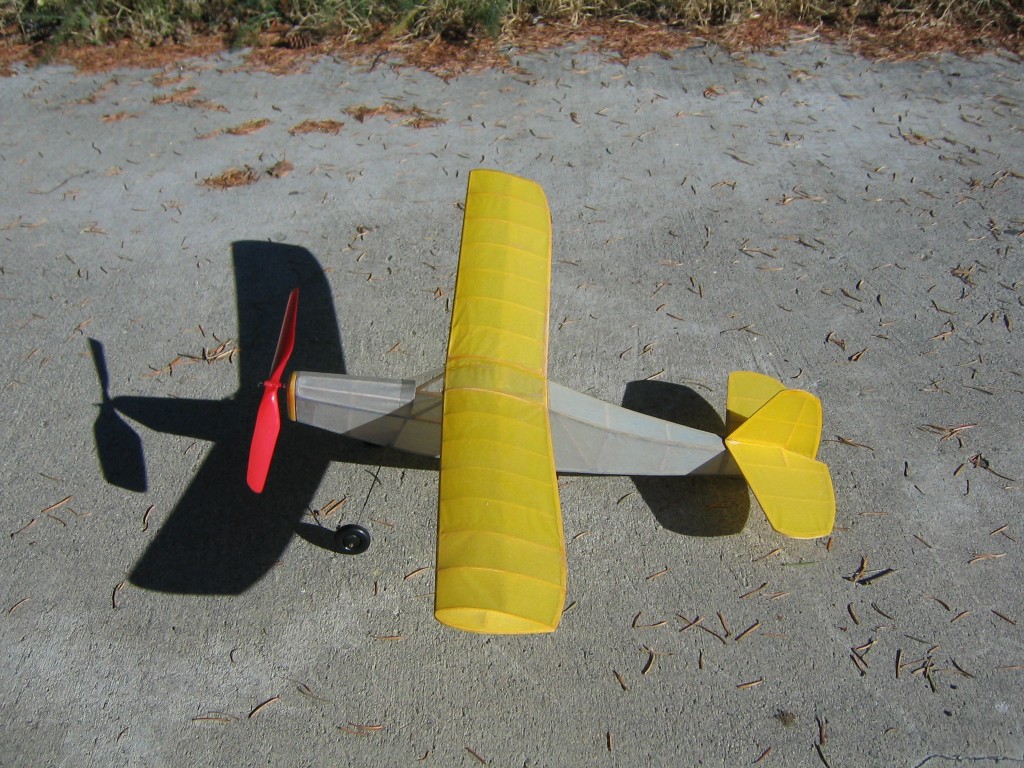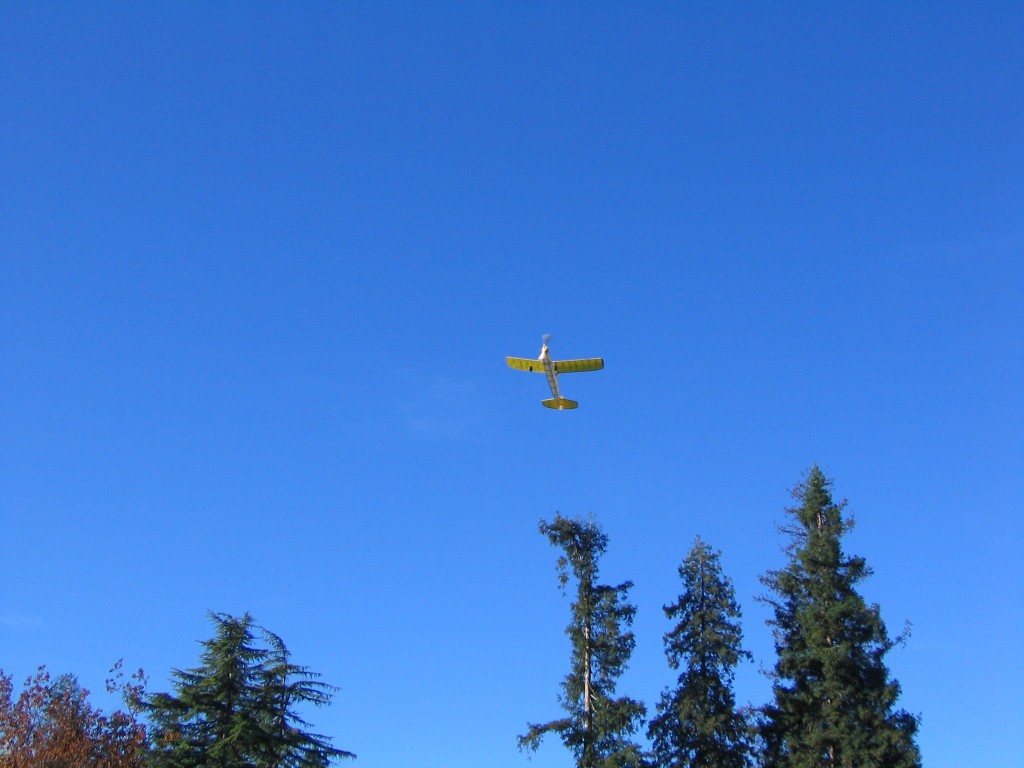A discussion of airplanes with long noses suitable for wood propellers led me to retrieve my Sig Tiger from the shop, where it has been sitting on top of a column of boxes for many years.
This is a very good beginner plane because the instructions are very thorough and the plans are very clear. I chose it to teach my son how to build a flying model airplane. Unfortunately it’s flight performance is problematical.
He and I each built one in 1997, when he was 16. His flew. It would climb out straight ahead, cruise on for a bit, then come down in a straight descent. It would fly the length of the available field. That limited the number of turns we put into the motor. On mine, the glide seemed OK at first, but under power it would start out on the straight climb, but at apogee, it would whip into a tight right spinning dive. Three point crash landings on the wheels and the nose cracked the wing roots. The trailing edge of the right wing had a slight upward bow. I fixed that, but that didn’t fix the flight pattern. I also added 2 grams of solder to the tail to correct a forward CG and rebuilt the center of the wing to correct the reduced dihedral, which I judged to be too high on the plan and reduced in the build. (I may have been right.) I carefully shimmed the tailplane to perfect alignment. I checked lateral balance and rudder alignment. Severe vibration of the noseblock resulted from the angle between the prop shaft and the motor. I moved the motor peg up to reduce the angle and shimmed the nose block with paper to tighten the fit. All my tinkering made it worse. Now it would spiral right in the glide. I never put more than about 150 turns into the motor. So it sat in the shop for 15 years.
I got it out with the intention of replacing the heavy plastic prop with a light balsa prop and removing the 2 grams of lead in the tail. Reducing the mass moments might also improve the stability.
I tried glide tests and powered flights with the same results as before. I still couldn’t see what was causing the problem. Usually warps cause worse problems under power. That it would start out flying straight and then spin in was puzzling.
The Sig 6 7/8″ Hi-Torque prop has a linear blade angle distribution, what you get from a can formed blade. The blade angle of the chord goes from 36.5 degrees at 29% to 24.7 at 95%. The aerodynamics are determined by the zero lift angle, which is 10.6 degrees higher than the blade chord angle. This has a very deep arc airfoil. This produces a P/D of 0.99 at 29% and 2.13 at 95%. Replacing this with a properly pitched carved prop would have aerodynamic advantages as well as saving weight.
The Sig prop weighs 4.3 grams. I calculated the weight of prop required to remove the 2 grams of tail ballast and got 1.5 grams. I had a 1.5 gram Cloud Tramp balsa prop which had P/D = 1.2. I had a second nose block with a Peck plastic prop that I had tried years ago, so I switched that with the balsa prop. Replacing the plastic prop with the balsa prop and removing 2 grams of tail ballast reduced the weight a total of about 5 grams, from 35.0 grams all up weight to 30.0 grams. The CG was a bit aft with the motor in, possibly because of a difference in noseblock weights, so I added 0.5 gram of clay to the noseblock.
I went to the small local park and tried flying with the plastic prop and the leading edge of the fin offset about 3/32″ right, to make a left turn. It still started flying straight, but instead of a tight spinning dive, it did a tight,steep helical descent. The CG was 0.6″ ahead of the plan location.
Next I tried the balsa prop. By this time I had an audience of about a dozen small boys and a couple little girls. With 100, 150 and 200 turns on the motor, it climbed gradually in a straight line, slight phugoid and slight Dutch roll, then made a straight descent with a slight right turn at the end. The CG was 0.1″ behind the plan location. It looked like I would need another 0.4 grans of weight on the prop. I had a 1.6 P/D Cloud Tramp prop weighing 1.9 grams, exact match for weight and I preferred the higher P/D. The empty weight is now 27.5 grams, and with the 3.5 gram motor, the CG is exactly where the plan calls it. (I weighed the motor from a kit and got 5.1 grams. Both motors were very close in length, but the heavy one was much thicker.)
Flight tests with 100, 150, 200, 250, 300 and 350 turns were similar. Slight Dutch roll, large diameter circle to the right, tightening slightly on descent, no steep dive, turns left in motor on landing. Last flight, the right wing hit a tree and cracked the wing root, shattered the center section tissue covering (again).
So what is going on here? All of the small warps and asymmetries would seem to produce a left turn. Motor torque would produce a left bank, sideslip and turn. But it flies in a right turn. The thrustline passes well above the CG. This would pitch the plane down. When the thrust dies off, it would pitch up. Running along the ground with the prop pitched up about 6 degrees, it turns right. Could it be propeller effect? Hard to know, since I don’t know prop attitude in flight. Also, with 5 1/2 degrees of downthrust, most of the side area is in the lower portion of the propwash, which is active even during freewheeling, and that would produce a right turn. That’s a theory that I can test.
I removed the prop and motor and placed 2.7 grams of clay on the nose to make CG. This made a nice straight glide with a slope of about 5:1. The right turn is not caused by any twist or warp, it is caused purely by the action of the propeller. There was no Dutch roll. The high pitch propeller out on that long nose counteracts the fin area. That reduction of fin effectiveness is probably what causes the Dutch roll. A slightly larger fin would fix that minor problem.
I decided to try a 5/64″ shim at the bottom of the noseblock to bring the thrustline and slipstream down, see if that fixes the spin. I suspect that the vibration of the motor works the noseblock loose, so the plane flys properly only when the thrustline is out of plan alignment.
The 5/64″ shim along the bottom of the noseblock brings the downthrust down to 2.25 degrees and attack angle to 6.75 degrees. Powered flights with the 1.6 P/D balsa prop flew nice consistent right circles, good climb, no spin in, landing consistent with power circle. At 400 turns, the circle opened up, it went across the field and landed in a tree, out of reach, maybe 12′ up. Getting dark, threatening rain, I didn’t want to leave it unattended while going home to get the pole, so I found a branch in some rubbish in the street and poked it down, but broke the tailplane in four places. Easy enough to repair. I got the number of turns that produces a level flight. That will allow me to design the optimum motor. I think I can get two minutes out of it, but that will require a bigger field. The instructions say you can put 600 turns into the motor, but this one is 15 years old. With Tan II rubber 2,000 turns would be possible, and the motor could be made thinner and longer for even more turns.
I repaired the tailplane and took it to a slightly bigger park. Here it is flying again.


Interesting that your sons Tiger flew well, albeit straight but I dont see any comparison made between yours and his despite the totally different flying characteristics.
I didn’t spend time on his, so don’t know what the differences may have been. He didn’t put as many turns into his, so the power troubles may not have developed.